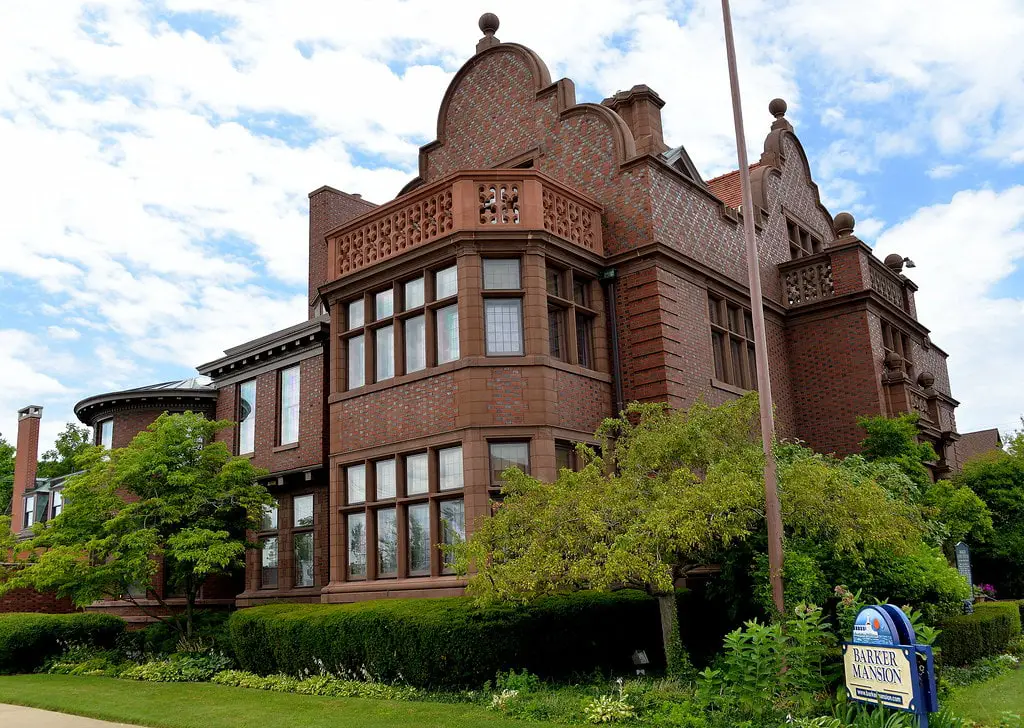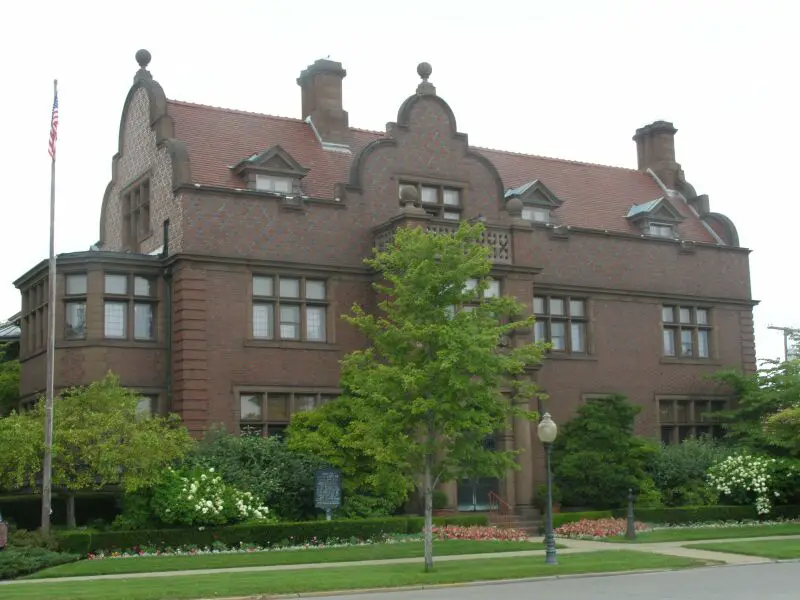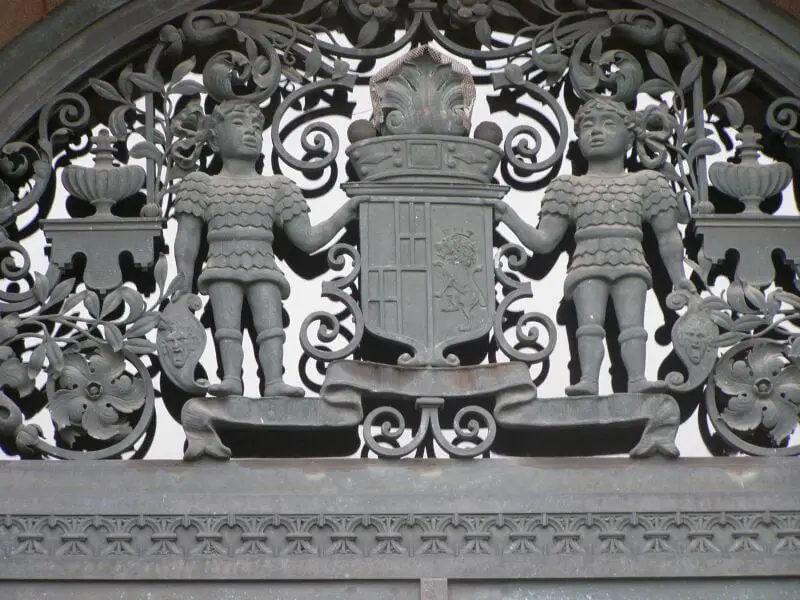The Historical Significance of Barker Mansion
Nestled in the heart of Michigan City, Indiana, the Barker Mansion is a testament to the city's rich history and architectural grandeur.
Originally erected in 1857, this magnificent structure began as a modest two-story brick house. Over the years, it evolved into a sprawling estate, reflecting the prosperity and vision of its owners.
The original structure of the mansion, now serving as the rear wing, was a foundational piece of this architectural marvel.
The mansion underwent a significant transformation between 1905 and 1909, in the early 20th century.
The main block of the mansion was constructed under the guidance of architect Fredrick Perkins, who is known for his expertise in English Manor designs.
This expansion brought the mansion to its current glory, boasting 38 rooms, 10 bathrooms, and seven fireplaces, each detailing the era's luxury.
The Barker Mansion's architectural style is a blend of maroon brick and limestone trim, a hallmark of the English Manor aesthetic popular among affluent families of the time.
The mansion's expansive layout, with its numerous rooms and intricate designs, served as a comfortable residence and a symbol of the Barker family's status and success in the industrial world.
In 1975, the Barker Mansion was officially recognized for its historical and architectural significance and listed on the National Register of Historic Places.
This listing acknowledged the mansion's past and committed it to preservation for future generations. The mansion's inclusion in the Haskell and Barker Historic District further cemented its status as a key landmark in Michigan City.
Things to do in Michigan City, Indiana, often include visiting this historic site, where one can step back in time and experience the grandeur of the early 20th century.
The mansion's well-preserved state offers a unique glimpse into the lifestyle of one of the city's most influential families, the Barkers, who played a pivotal role in shaping the region's industrial landscape.
Today, the Barker Mansion is a piece of history and a bridge connecting the past to the present. It's a place where architecture enthusiasts, history buffs, and casual visitors alike can explore and appreciate the legacy of an era that significantly impacted Michigan City's development and culture.
John H. Barker: The Man Behind the Mansion
Early Life and Ventures
The story of the Barker Mansion is inextricably linked to the life of John H. Barker Sr., whose journey began in 1836 when he arrived in Indiana from Andover, Massachusetts.
At 22, Barker Sr. embarked on a series of entrepreneurial ventures, initially establishing himself as a general merchant.
His business acumen quickly led him to expand into grain brokerage, a thriving industry in the burgeoning Midwest.

Railroad Industry Impact
Barker Sr.'s foresight in recognizing the potential of the railroad industry marked a turning point in his career.
In 1855, he invested in a company that would soon become a cornerstone of Michigan City's economy - the Haskell & Barker Car Co.
Initially focused on manufacturing freight cars, this company saw exponential growth, especially with the onset of the American Civil War.
The war brought lucrative government contracts, propelling the company and, by extension, Michigan City into a period of prosperity.
Legacy and Wealth
John H. Barker Jr., inheriting his father's business acumen, took over the reins of Haskell & Barker Car Co. in 1869.
Under his leadership, the company flourished, amassing a fortune estimated between fifty to sixty million dollars at his death in 1910.
This immense wealth signified the Barker family's success and underscored their business's significant impact on the local economy and community.
Architectural Marvel: Design and Features of the Mansion
Design Overview
Today, the Barker Mansion is a remarkable example of English Manor architecture, a style meticulously brought to life by architect Fredrick Perkins.
The mansion's exterior, characterized by its maroon brick and limestone trim, exudes grandeur and timelessness.
The sprawling estate, which encompasses 38 rooms, 10 bathrooms, and seven fireplaces, is a testament to the Barker family's lavish lifestyle.
Interior Splendor
Inside, the mansion showcases exquisite craftsmanship and artistic excellence. Each room is adorned with intricate woodwork, bespoke furnishings, and a collection of art that reflects the cultural tastes of the era.
The attention to detail in the design of each space, from the grand ballroom to the intimate family quarters, reveals the meticulous planning and investment in creating a luxurious and comfortable home.

Landscape and Gardens
Mughtly landscaped gardens and outdoor spaces surround the mansion, which was as much part of the estate's design as the house itself.
These gardens, with their formal layouts and variety of plantings, provided a serene and picturesque setting, complementing the mansion's architectural elegance.
They served as a space for relaxation, entertainment, and a display of the family's status and appreciation for nature's beauty.
The Barker Mansion Today: A Cultural and Educational Hub
Public Access and Tours
Since transforming into a public museum, the Barker Mansion has opened its doors to visitors, offering a window into the past.
The meticulously preserved mansion provides guided tours that delve into its history, architecture, and the Barker family's legacy.
These tours, often led by knowledgeable guides, provide insights into the mansion's role in Michigan City's development and the lifestyle of the early 20th century's elite.
Events and Activities
Beyond its historical tours, Barker Mansion has become a vibrant center for cultural activities. It hosts various events throughout the year, including musical performances, lectures, and specialty tours.
These events celebrate the mansion's history and bring the community together. The mansion also organizes city walking tours, allowing visitors to explore Michigan City's rich heritage beyond the mansion's walls.
Community Engagement
The mansion's significance extends to its role as a venue for private and public events. It is a sought-after location for weddings, nonprofit meetings, family gatherings, and photo shoots.
The mansion's elegance and historical ambiance make it an ideal backdrop for various events, contributing to the local community's social and cultural life.

Recent Developments and Restoration Efforts
Ongoing Preservation
Preserving Barker Mansion is an ongoing effort, ensuring that this historical landmark remains in its best condition for future generations.
Recent restoration projects have focused on maintaining the integrity of the mansion's original design while incorporating modern amenities for visitors' comfort. These efforts are crucial in keeping the mansion's history alive and relevant.
New Exhibits and Features
In its commitment to education and cultural enrichment, the mansion has introduced new exhibits offering deeper insights into the Barker family's history and impact on Michigan City.
These exhibits, often featuring artifacts, photographs, and documents, provide a comprehensive understanding of the mansion's historical significance.
Visitor Experience Enhancements
The mansion has undergone several upgrades to enhance the visitor experience. These include improved accessibility features, ensuring that the mansion welcomes all visitors, regardless of physical ability.
The introduction of interactive displays and multimedia presentations has also enriched the educational aspect of the mansion tours, making history more engaging and accessible to a broader audience.
The Barker Legacy: Impact on Michigan City
Economic Contributions
The Barker family, through their enterprise Haskell & Barker Car Co., played a pivotal role in the economic development of Michigan City.
Established in the mid-19th century, the company rapidly became one of the city's largest employers. Its success in manufacturing freight cars boosted the local economy and positioned Michigan City as a significant player in the railroad industry.
The prosperity brought by the company facilitated the growth of other businesses and services in the area, contributing to the city's overall economic health.
Philanthropic Endeavors
Apart from their business achievements, the Barkers were known for their philanthropic activities. Their contributions extended to various sectors, including education, healthcare, and public services.
The family's generosity was crucial in establishing and supporting local institutions, impacting the community's well-being and development.

Cultural Significance
Beyond being a family home, the Barker Mansion symbolizes Michigan City's cultural heritage. Its preservation and transformation into a museum have allowed the public to connect with the city's past.
The mansion reminds us of the city's historical journey and the significant role played by the Barker family in shaping its course.
Personal Stories and Anecdotes
Visitor Impressions
Recent visitors to the Barker Mansion have shared glowing reviews, highlighting the mansion's beauty, historical significance, and the informative nature of the tours.
These testimonials often mention the well-preserved state of the mansion and the guides' engaging storytelling, which brings the history of the Barker family and Michigan City to life.
Staff Insights
The staff at Barker Mansion, many of whom have dedicated years to its upkeep and presentation, offer unique perspectives on the mansion's history and significance.
Their insights from extensive experience and research provide a deeper understanding of the mansion's role in the community and the ongoing efforts to preserve this historical landmark.
Historical Anecdotes
The mansion's history is rich with intriguing anecdotes about the Barker family and their times. These stories, ranging from tales of grand parties held in the mansion to accounts of the family's involvement in the city's affairs, offer a glimpse into the lifestyle and social dynamics of the era.
These anecdotes entertain and provide a human element to the mansion's history, making it more relatable and vivid for visitors.
